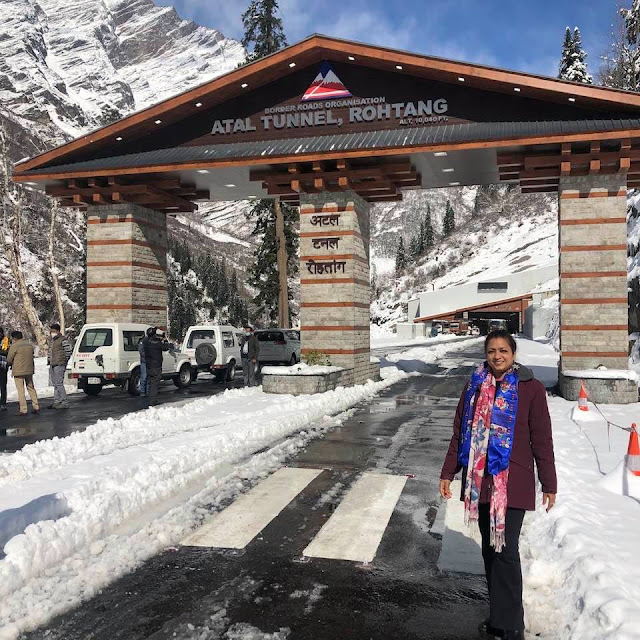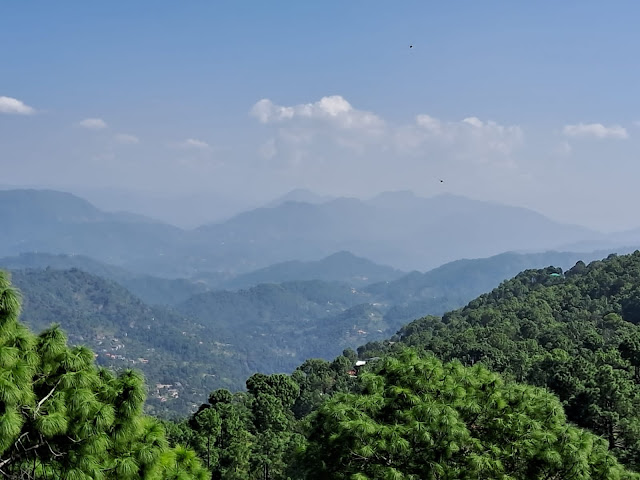PANGI VALLEY - Land of Pangwals and Bhots AND of Glaciers and Waterfalls
Ever since I got married and came to Himachal I have been hearing about
these far flung areas of the state – shrouded in mysteries - considered to be difficult;
but very beautiful. They lacked basic facilities, road connectivity and had
extreme weather conditions. That’s why perhaps were not high on the tourists
list as well. Lot has changed and changing since than.
Pangi Valley is one of them
We went via Lahaul because Saach pass had not opened after the winters.
And as soon as we started travelling ahead of Keylong the question which popped
in my head was -'why people settled in such a remote and difficult area in
ancient times?'- especially when the entire Himachal was and is not overly
populated?
There are no authentic historical evidence about the origin of human
settlement in Pangi valley; but stories are there and all of them seem to be
probable. The Pangwals (Aryan descendants) - a common term for all
Hindus living in Pangi (mainly Rajputs, Brahmans, Lohars etc) – were
either sent or came from Chamba and Lahaul. It is said that the Raja of Chamba
used to send the miscreants of its kingdom to Pangi area - almost a Kala Pani –
not expected to return to the main land. That is why the traditional cap (made
of white cotton cloth) of Pangi resembles that of a prisoner and is different
from rest of the Himachal. Some migrated on their own for better grazing lands
and resources. The Rajputs feel that their ancestors probably came here to hide
from Muslim invasions but could never travel back and then got mixed with locals. Pangi
also has a sizeable population of Mongoloid origin Buddhists - called the Bhots-
who probably came here to seek refuge from persecution. They live in the higher reaches of the valley
called Bhatoris - Sural Bhatori, Chasak Bhatori, Hill Tuwan Bhatori
etc. – the most beautiful meadows of the valley.
Now what is it that I found noticeable about Pangi–
1-
Its remoteness – it really is remote, but its
remoteness creates a mystery and retains
its uniqueness
2-
Glaciers and Water falls – almost everywhere and
easily accessible – a topography not common in Himachal
3-
Its serene beauty – the valley is green with tall
Devdaars and other trees - unlike other high altitude areas. Also the entire region
is full of rivers and nallahs adding to the beauty.
4-
Less Consumerism – hardly any big buildings, few dhabas,
less plastic and garbage and thankfully not many chips packets. A traditional peaceful
way of life.
5-
Happy people with regional pride – both Pangwals and
Bhatoris
As soon as we travelled ahead of Udaipur the road became nonexistent with
only few good patches. But what made up for the bad road was the amazing
landscape - full of trees, Chandrabhaga traversing with us down the deep gorge and
lots and lots of glaciers and water falls. The water falls running over the
roads were exciting and scary at the same time. I longed to get down and walk
over them but refrained as we were in a rush to reach Killar before the dark. (Though
I did it on my way back)
While Prabodh was busy with his meetings the next day, I enjoyed dressing up in Pangwali dress and tried wearing Joji (head dress); though I could manage to retain it only for a while. It is influenced by Chamba in its jewellery (all still comes from there), the traditional chaddar (shawl) probably is influenced by the Europeans (Pangi had early European travelers) as it has check design which is not common in other parts of Himachal. The draping style is also unique.
We got to taste the local cuisine when we visited Hill Tuwan Bhatori. We
also experienced the culture and hospitality of the Bhots – a relaxed way of
life totally in sync with the nature. Millets are commonly consumed in
different style and cooking is almost primitive with minimal use of spices
retaining natural flavors. Our meal with
them was a cherishable experience with local red potatoes, various chutneys (sauces),
Churu (Local cow – a mix breed between Yak and Cow) cottage cheese, local honey
and other savouries. I enjoyed it to the hilt. In fact requested them to pack
some red potatoes to take back home. And
if I don’t mention Pangi ki Thangi (local hazelnuts) and Tilmil Ka
Pani (mineral water from a local water source) my blog will not be
complete.
A warm welcome by the Bhots of Hill Tuwan
The Barley Cake (Jaun ka Sattu) - a must welcome and a staple diet
Pangi ki Thangi - local Hazelnut 


We couldn’t travel to the most beautiful areas of Pangi – the Bhatoris
especially Sural and Hudan Bhatori beacuse of weather conditions - but it is said that these places are worth
visiting. Already the tent colonies are being set up during
summers and more and more people, especially motor cyclists, are travelling to
the valley.
Though very difficult to live in early times – even 15 years back - now
Pangwals are optimistic for future connectivity and facilities and have plans
to grow exotic vegetables and fruits for outside market (the trend has already started). They are looking forward to NHPC’s Duggar (500 MW) power project and
feel that better roads will bring high-end tourists. The area already has
better amenities as I noticed in the local school and college during my brief
visit - modern labs, solar lights, computers, internet and teachers from
outside the valley. The Physics lecturer- Mr Hemendra Singh- in college is from Rajasthan and looked totally
at ease with his surroundings. Told me that he is loving the climate here and
intends to serve in Pangi for more years.
The Himachal Government is also spending a lot of money for trying to improve the connectivity and amenities in the Valley.
One day in Pangi valley was not enough to get the entire feel of it (I
shall surely visit it again), but I realized that Pangi has a future in tourism. If someone is looking for a
truly rugged mountainous adventure, beautiful untouched treks, pristine beauty,
traditional organic food, almost nomadic ways of life – almost travelling back in time – and ready to brave
the topographical challenges - than the destination is Pangi. You shall
experience what it is to be one with nature – its beauty and its challenges. 



































Really nice and informative blog mam , all pictures are so beautiful in this beautiful valley. And Ritika Jindal mam is really a big inspiration for our young girls.
ReplyDeleteWonderful Ma'am.....Your description of Pangi is absolutely captivating, painting a vivid picture that truly brings out the region's natural beauty and cultural richness. Your words are both evocative and enchanting, making the allure of Pangi almost palpable.
ReplyDeleteWhat an awesome read, your blogs make the places and people actually come live to the readers 💯
ReplyDeleteIt’s a stunning place Anurita!! every such adventure must be changing you a little too. The simplicity of people, minimalist living and finding happiness in nature is something even people like us living in cities can do. Keep spreading joy 🤩💖
ReplyDelete
ReplyDeleteI appreciate your captivating blog on Pangi. Your detailed portrayal of the valley, enriched with exclusive pictures of its unique culture and cuisine, has truly resonated with me. The vivid imagery and insightful descriptions have not only deepened my understanding of this remarkable region but also ignited a profound desire to experience Pangi firsthand.
The rich heritage and culinary delights of the valley, is both enchanting and inspiring. Thank you for sharing such a valuable and engaging piece.
Very adventurous tour indeed. I liked the images and information.
ReplyDeleteVery good information dear. U r looking awesome 👌 👏 👍
ReplyDeleteAwesome
ReplyDeleteI have nostalgia of my many a visit to Pangi. Her talent with a scholarly tinge makes Anurita's write-up a great narrative.
ReplyDeleteThanks a lot everyone 🙏
ReplyDeleteAwesome pictures have refreshed my memories. I served in Pangi Valley from 1990 to 1992. I had opted to serve in that remote valley. I have travelled extensively throughout the valley on foot. I have travelled on foot through Sach Pass, Lahaul Valley and Paddar Valley in J&K.
ReplyDeleteVijay Laxmi Tiwari
A very well written, elaborative and excellently illustrated blog on Pangi, Madam. You have written it in such a captivating manner that one feels like traveling in Pangi valley itself.
ReplyDeletePangi valley is in fact a combination of many sub valleys where one finds different attractions and challenges and goes through some of the unforgettable experiences while travelling and trekking .You must have seen the adamantine mountains and other rugged terrains on the one hand and flowing streams and gushing rivulets producing a sonorous music on the other.The trees of deodar also festoon some of the areas of sub valleys.There are some patches where one sees the charm and attraction of natural flowers emitting its redolence all around during summer season.The valley has a lot of potential from tourism point of view and if exploited and developed to the hilt, the same could create wonders by opening up new avenues and vistas for tourists.After visiting the entire Himachal especially hard, interior , far flung and inaccessible areas , you must have experienced the different shades, patterns, colours ,traditions and over all cultural multeity which becomes quite palpable through your blogs ma’am.
ReplyDelete